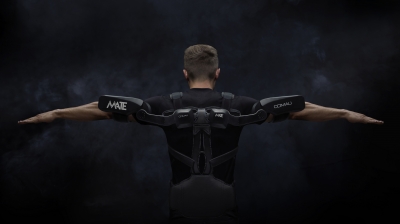
Comau introduces MATE, its first innovative wearable exoskeleton. MATE has been designed to improve work quality in an efficient and highly ergonomic manner by providing consistent and advanced movement assistance during prolonged overhead, as well as daily tasks.
The MATE Fit for Workers exoskeleton used an advanced passive structure. MATE delivers lightweight, breathable and highly effective postural support without the need for batteries, motors or other devices. It is also compact and ergonomically designed thanks to the partnership between Comau, ÖSSUR, a leading non-invasive orthopedics company, and IUVO, a spin-off company of The BioRobotics Institute (Scuola Superiore Sant’Anna) specialized in wearable technologies. MATE is fully able to replicate any movement of the shoulder while adhering to the body like a “second skin.”
Reflecting Comau’s vision and commitment to innovative, open and easy-to-use technologies, MATE is an important part of the company’s HUMANufacturing technology strategy, a concept in which people play the leading role within the smart factory alongside cutting-edge digital tools, enabling technologies and ‘intelligent’ industrial robotics within a networked production system. Developed in conjunction with IUVO and ÖSSUR, MATE is the first available product of a series of wearable technologies being commercialized by Comau. A fundamental aspect of the cooperation is the joint desire to progress and evolve human-machine collaboration within diverse sectors, including: biomedical, manufacturing and consumer. MATE was designed and developed at the Comau HUMANufacturing Innovation Center in Pontedera (Pisa), Italy.
Features:
• Designed in close collaboration with factory workers engaged in manual activities
• Naturally comfortable, breathable postural structure
• Compact structure fully follows the movements of the upper limbs without resistance or misalignment
• Passive mechanism – no need for battery, motors or other devices
Benefits:
• Reduction of shoulder muscle activity
• Users can do the same tasks with less fatigue
• Consistent, ergonomically-assisted movement support increases the quality and precision of overhead tasks
• Users can improve the quality of their work
Contact Details
Related Glossary Terms
- fatigue
fatigue
Phenomenon leading to fracture under repeated or fluctuating stresses having a maximum value less than the tensile strength of the material. Fatigue fractures are progressive, beginning as minute cracks that grow under the action of the fluctuating stress.
- robotics
robotics
Discipline involving self-actuating and self-operating devices. Robots frequently imitate human capabilities, including the ability to manipulate physical objects while evaluating and reacting appropriately to various stimuli. See industrial robot; robot.






